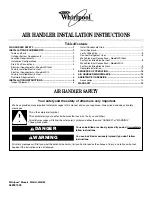
010-200002-000
Page 25
HB IOM 1.1 2-13-2014
Following the piping diagrams in Fig. 26-31, make all
connections while observing the following precau-
tions:
• Install a drip line and trap on the pressure side of
the inlet control valve. Connect the drip line to the
return line downstream of the return line trap.
• To prevent scale or foreign matter from entering
the control valve and coil, install a 3/32-in. mesh
strainer in the steam supply line upstream from the
control valve.
• Provide air vents for the coils to eliminate noncon-
densable gases.
• Select a control valve according to the steam load,
not he coils supply connection size. Do not use an
oversized control valve.
• Do not use bushings that reduce the size of the
header return connection. The return connection
should be the same size as the return line and re-
duced only at the downstream trap.
• To lift condensate above the coil return line into
overhead steam mains, or pressurized mains, install
a pump and receiver between the condensate trap
and the pressurized main. Do not try to lift conden-
sate with modulating or on-and-off steam control
valves. Use only
15-degree check valves, as they open with a lower
water head. Do not use 45-degree or vertical-lift
check valves.
• Use float and thermostatic traps. Select the trap
size according to the pressure difference between
the steam supply main and the return main.
• Load variations can be caused by uneven inlet air
distribution or temperature stratification.
• Drain condensate out of coils completely at the end
of the heating season to prevent the formation of
acid.
Coil Freeze-Up Protection
STEAM COILS — When used for preheating out-
door air in pressure or vacuum systems, an immer-
sion thermostat to control outdoor-air damper and
fan motor is recommended. This control is actuated
when steam supply fails or condensate temperature
drops below an established level, such as 120 to
150 F. A vacuum breaker should also be used to
equalize coil pressure with the atmosphere when
steam supply throttles close. Steam should not be
modulated when outdoor air is below 40 F.
On low-pressure and vacuum steam-heating sys-
tems, the thermostat may be replaced by a conden-
sate drain with a thermal element. This element
opens and drains the coil when condensate temper-
ature drops below 165 F. Note that condensate
drains are limited to 5 psig pressure.
INNER DISTRIBUTING TUBE STEAM COILS —
The inner distributing tube (IDT) steam coil used in
the HB air handling units has an inner tube pierced
to facilitate the distribution of the steam along the
tube's length. The outer tubes are expanded into
plate fins. The completed assembly includes the
supply and condensate header and side casings
which are built to slant the fin/tube bundle back to-
ward the condensate header. The slanting of
the assembly ensures that condensate will
flow toward the drains. This condensate must
be removed through the return piping to pre-
vent premature failure of the coil. The fin/tube
bundle is slanted vertically for horizontal air-
flow coils, and horizontally for vertical airflow
coils.
IDT Steam Coil Piping — The following piping
guidelines will contribute to efficient coil oper-
ation and long coil life:
1.
Use full size coil outlets and return piping
to the steam trap. Do not bush return out-
let to the coil. Run full size to the trap,
reduce at the trap.
2.
Use float and thermostatic (F & T) traps
only for condensate removal. Trap size
selection should be based on the differ-
ence in pressure between the steam sup-
ply main and the condensate return main.
It is good practice to select a trap with 3
times the condensate rating of the coil to
which it is connected.
3.
Use thermostatic traps for venting only.
4.
Use only 1/2-in., 15-degree swing check
valves installed horizontally, piped open
to atmosphere, and located at least 12 in.
above the condensate outlet. Do not use
45-degree, vertical lift and ring check
valves.
5.
The supply valve must be sized for the
maximum anticipated steam load.
6.
Do not drip steam mains into coil sec-
tions. Drip them on the pressure side of
the control valve and trap them into the
return main beyond the trap for the coil.
7.
Do not use a single trap for two or more
coils installed in series. Where two or
more coils are installed in a single bank,
in parallel, the use of a single trap is per-
missible, but only if the load on each coil
is equal. Where loads in the same coil
bank vary, best practice is to use a sepa-
rate trap for each coil. Variation in load on
different coils in the same bank may be
caused by several factors. Two of the
most common are uneven airflow distribu-
tion across the coil and stratification of
inlet air across the coil.
8.
Do not try to lift condensate above the coil
return into an overhead main, or drain into
a main under pressure with a modulating
or on/off steam control valves. A pump
and receiver should be installed between
the coil condensate traps and overhead
mains and return mains under pressure.
9.
Use a strainer (3/32-in. mesh) on the
steam supply side, as shown in the piping
diagrams, to avoid collection of scale or
other foreign matter in the inner tube dis-
tributing orifices.









































